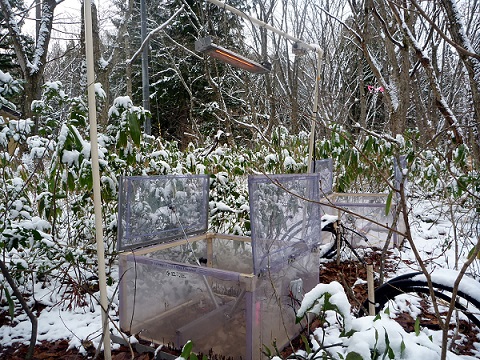Global Warming Stimulates CO2 Emissions from Forest Soil in Shirakami-Sanchi


Globally, 360 Gt of CO2 is emitted from soils (soil respiration) and released to the atmosphere every year. About 70% of soil respiration is derived from decomposition of Soil Organic Carbon (SOC) by soil microbiota (heterotrophic respiration). Heterotrophic respiration exponentially increases with increasing temperature; consequently, the carbon released to the atmosphere by increased heterotrophic respiration could cause positive feedback that further accelerates global warming. However, long-term response of heterotrophic respiration to global warming remains obscure and observation data that verify the response are limited.
The National Institute for Environmental Studies (NIES) and Hirosaki University have collaboratively conducted a soil warming experiment in a cool-temperate broad-leaved deciduous forest in Shirakami-Sanchi since September 2011 as a part of a project to evaluate the potential carbon sink or source strength of Japanese forest soils and its response to climate change. Shirakami-Sanchi is a mountain range (one of UNESCO world heritage sites in Japan) where cool-temperate forest ecosystems in the region are kept from human disturbance.
We concluded that global warming will long-term enhance SOC decomposition in humid cool-temperate forest ecosystems such as that in Shirakami-Sanchi. Abundant SOC and humid environment were the primary factors contributing to the long and high level of the warming effect. Our results also suggest that existing models and global estimations of terrestrial carbon-cycle feedbacks for global warming in the Asian monsoon region might be underestimated.
We increased the soil temperature at a depth of 5 cm by about 2.5 °C using infrared carbon-filament heat lamps, and continuously monitored CO2 efflux from the soil surface and related environmental parameters with a multichannel automated chamber system. Based on a soil warming experiment from the end of 2011 to the end of 2016, we observed that heterotrophic respiration increased by 6.2 to 17.7% (10.9% for 5-year average) per 1oC temperature rise (warming effect, Figure 1). In addition, the inter-annual variation of the annual warming effect on heterotrophic respiration was positively related with the number of rainy days (Figure 1), suggesting the importance of humid environment for sustained stimulatory warming effect. Furthermore, the Q10 values for heterotrophic respiration (the temperature sensitivity of heterotrophic respiration that expresses the magnification per 10 °C temperature increase) ranged from 2.40 to 2.85 (2.66 for 5-year average), larger than 2.0 that is used in many models for estimating future climate change.
This research has been published on 6th April 2018 in Journal of Geophysical Research: Biogeosciences.
Figure 1. (a) Annual warming effect on heterotrophic respiration by 1oC artificial soil warming, (b) Relationship between annual warming effect on heterotrophic respiration and number of rainy days
Article:
Teramoto, M., Liang, N., Ishida, S., Zeng, J. Long-term stimulatory warming effect on soil heterotrophic respiration in a cool-temperate broad-leaved deciduous forest in northern Japan. J. Geophys. Res. Biogeosci, doi: 10.1002/2018JG004432 (2018).
This research was supported by the Environment Research and Technology Development Fund (2-1705) of the Environmental Restoration and Conservation Agency, the Global Environment Research Fund (B-073) and Global Environment Research Coordination System (Evaluation of the potential effect of global warming on soil carbon emission of Japanese forest ecosystems) of the Ministry of the Environment, Government of Japan.
Contact:
Naishen Liang, Ph.D.
Head, Global Carbon Cycle Research Section
Center for Global Environmental Research
National Institute for Environmental Studies
16-2 Onogawa, Tsukuba, Ibaraki 305-8506, Japan
Email: liang(please append ‘@nies.go.jp’ to complete the email address)
Munemasa Teramoto, Ph.D.
Specialist, Global Carbon Cycle Research Section
Center for Global Environmental Research
National Institute for Environmental Studies
16-2 Onogawa, Tsukuba, Ibaraki 305-8506, Japan
Email: teramoto.munemasa(please append ‘@nies.go.jp’ to complete the email address)
Sachinobu Ishida, Ph.D.
Assistant Professor
Graduate School of Science and Technology
Hirosaki University
3 Bunkyo-cho, Hirosaki, Aomori 036-8561, Japan
E-mail: ishida(please append ‘@hirosaki-u.ac.jp’ to complete the email address)




